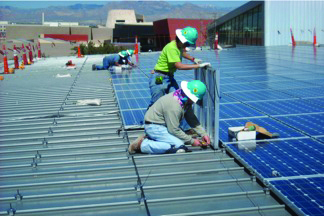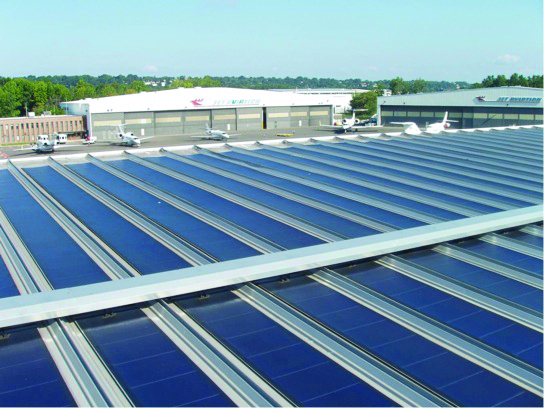- Products
- Industries
- Project Gallery
- Resource Center
- Metal Institute
- Shop
- Contact Us
August 1, 2012
by kbuchinger
In an effort to cut electricity costs and to help the environment by burning fewer fossil fuels, photovoltaic (PV) arrays are becoming very popular in spite of their significant installation costs. To further stimulate this trend, the DOE’s SunShot Initiative has been created to make solar energy costs competitive with other forms of energy by the end of the decade in an effort to drive widespread adoption of this renewable energy technology.
At the same time, in many areas of the country, electric energy providers are struggling to meet the growing energy demand during peak times of use. While they need to be able to provide sufficient capacity during these times, they don’t want to spend billions of dollars to build additional capacity that is only needed for a small portion of weekdays in the summer (and at night in the North during the winter). To help reduce electrical usage during these peak times, smart meters have been introduced and time of use (TOU) electrical rates are now offered, which charge more for electrical use during peak times and less during off peak times. Currently, in most cases, TOU is optional but, in a growing number of areas, is becoming mandatory.
Obviously, if you are on a TOU plan, you will want to minimize your electrical usage during the peak times. But, another way to save considerable money on your electric bill is to install a solar array on your metal roof. During the summer peak time when the electric company charges you the highest rate for your electricity, your PV array will be generating the most electricity to offset your usage. This helps both you and the electric companies save money – you save on your electric bill, and the electric companies hope to reduce the need for additional generation capacity.
The best place to install a PV array is generally on your roof, be it a home or commercial building. This keeps the equipment out of the way yet reasonably close to the building’s electric meter. So, if this is the best place to install a solar array, will my roof handle it? What do I mean by that? A flexible thin film PV array weighs about ¾ pound per square foot and a glass-based crystalline PV array weighs 3-4 pounds per square foot so your roof must be capable of supporting this additional weight. Your roof should also have minimal shading and a life expectancy equaling or exceeding that of the solar array. Otherwise the roof will have to be replaced one or more times during the approximate 30 year life of the PV array. This is especially true if the existing roof is 5-10 years old when the PV array is installed. Removing and installing the PV array adds a huge additional cost plus to the cost for the roof replacement(s).

So, what should a person do? Whether you are a homeowner or a commercial building owner, you should seriously consider ensuring that you have a “solar ready” roof. You may not want a PV array now, but if you decided to install one in the future, the roof would be capable of accepting it, and, just as important, last as long as the PV array. This would be easy to do with new construction but can also be done when it’s time to reroof. This is a hot topic in California where the California Energy Commission recently approved a new energy standard that includes a requirement for all residential and commercial buildings to have “solar ready” roofs beginning January 1, 2014. So what is the best roof type for a “solar ready” roof. In my opinion, it is a standing seam metal roof (SSMR), which is ideal for both commercial and residential applications.
Metal standing seam roofs are lightweight (great in seismic zones), fire resistant (excellent in wildfires), impact resistant (think hail), easily engineered to withstand winds of 130 mph and more and are extremely long life. The greatest attribute of the SSMR, however, is its longevity. Recent studies indicate that Galvalume® coated steel standing seam roofs are lasting 40-60 years. This means that even if your SSMR is 15 years old, it can still outlast a PV system, eliminating the roof replacement expenses previously mentioned.

Another valuable attribute of the SSMR is the ability to attach either the flexible thin film or the glass-based crystalline PV module to the SSMR panels without penetrating the roof or using an expensive racking system. Roof penetrations are both costly to waterproof and have the potential for leaks. Racking systems are generally required on other roof types. The material and installation costs of racking systems in addition to the penetration costs can often exceed the cost of the SSMR. In many cases, this means that by going with an SSMR in lieu of other roof types and eliminating the racking system for your PV array, you can save enough money on your PV installation cost to pay for your roof.
If you want to install a large PV array on a commercial building with a flat roof, you can often pay for a retrofit framing system with a SSMR that will far outlast other commercial roof types, increase your building energy efficiency and provide the perfect platform for you PV array.
With a multitude of benefits for a standing seam metal roof, coupled with the long term money savings of a PV array, it’s easy to see how solar and metal are truly the perfect combination.